Drawing lily flowers allows you to capture one of nature’s most elegant blooms on paper. Lilies make perfect subjects for artists of all skill levels with their distinctive trumpet-shaped petals and graceful forms. Whether you’re a beginner learning basic line techniques or an experienced artist refining your botanical illustration skills, lily drawings offer endless creative possibilities while improving your observation and rendering abilities.
The process of drawing lilies can be approached step-by-step, beginning with simple outlines and gradually adding details that bring the flower to life. Many artists start by sketching the center of the lily and then work outward, following the natural curve of each petal. As you practice, you’ll develop an eye for the subtle variations in petal shapes and the way light creates shadows across the flower’s surface.
Today’s artists have access to countless resources for improving their lily drawings, from online tutorials to reference photographs. You can experiment with different mediums too—pencil sketches capture delicate details, while watercolors highlight the lily’s luminous quality. Remember that the most important aspect of drawing lilies is to observe carefully and enjoy the creative journey.
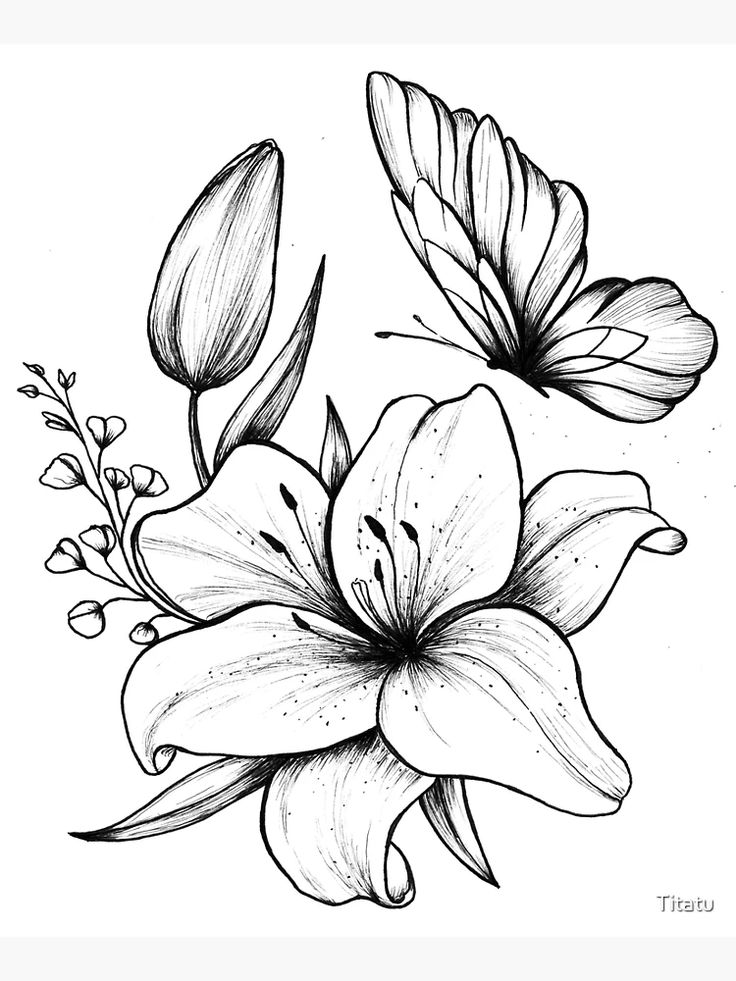
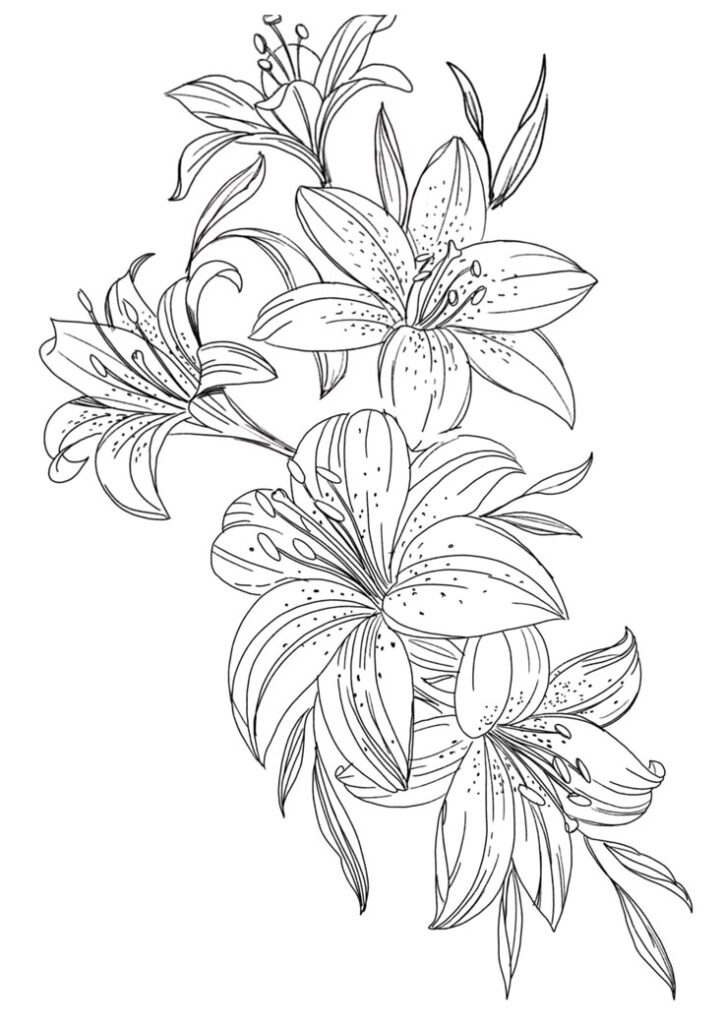
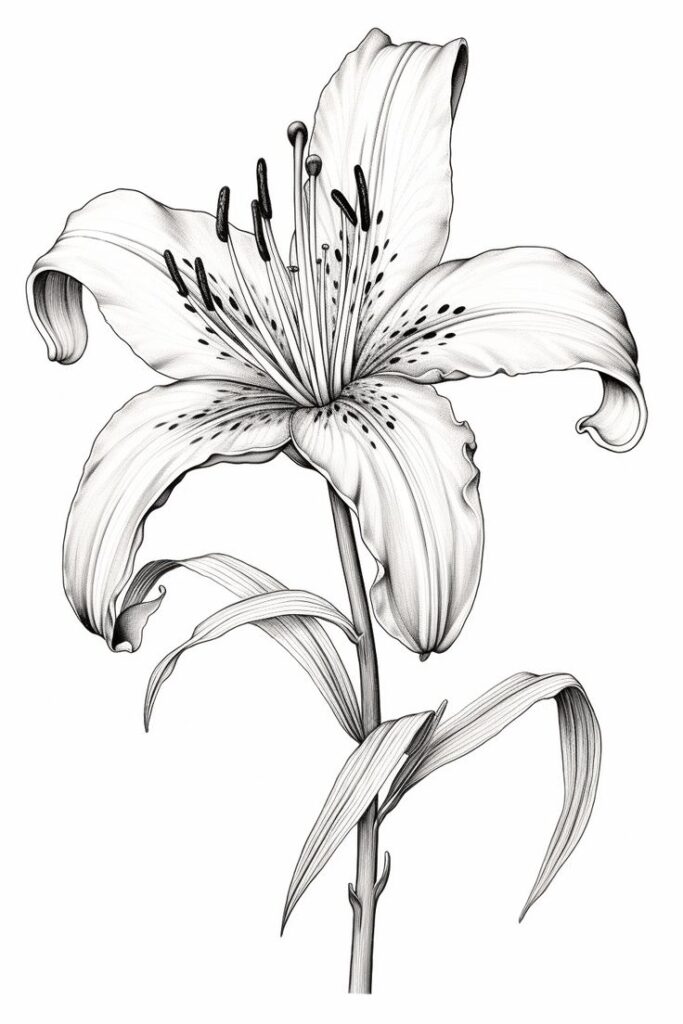
Key Takeaways
- Lily drawings combine technical skill with artistic expression while developing your eye for botanical details.
- Starting with basic outlines and gradually adding texture and shading creates the most realistic lily representations.
- Experimenting with different art mediums allows you to capture various aspects of lilies from delicate textures to vibrant colors.
Understanding Lily Flowers and Their Appeal in Art
Lily flowers have captivated artists for centuries with their elegant forms and rich symbolism. Their distinctive shape and cultural significance make them perfect subjects for artistic expression, whether you’re a beginner or experienced artist.
Symbolism and Types of Lily Flowers
Lilies are deeply symbolic flowers across many cultures. They often represent purity and new beginnings, which is why you’ll frequently see them in religious artwork, especially in depictions of the Virgin Mary. The white lily in particular symbolizes innocence and virtue.
Beyond the classic white lily, you’ll find numerous varieties worth exploring in your artwork. Tiger lilies with their vibrant orange spotted petals convey passion and enthusiasm. Yellow lilies represent friendship and happiness, making them cheerful subjects for your drawings.
Calla lilies, with their smooth, sculptural form, offer a different artistic challenge. Easter lilies bloom early and symbolize hope and renewal, perfect for springtime sketches.
Why Lilies Inspire Artists
Lilies appeal to artists because of their striking architectural structure. The trumpet-shaped blooms with their prominent stamens create dramatic focal points in any composition. You can play with perspective by drawing lilies from different angles.
The lily flower’s symmetry makes it an excellent subject for practicing proportion and balance in your artwork. Their clearly defined petals help you understand how light creates form and shadow.
Artists appreciate that lilies hold still longer than many flowers, making them ideal models for observation. Their bold outlines and distinctive shapes work well in both detailed botanical illustrations and more stylized interpretations.
The white lily’s contrast against green foliage creates natural drama in your compositions. When drawing lilies, you can emphasize texture through the smooth petals and rough stamens.
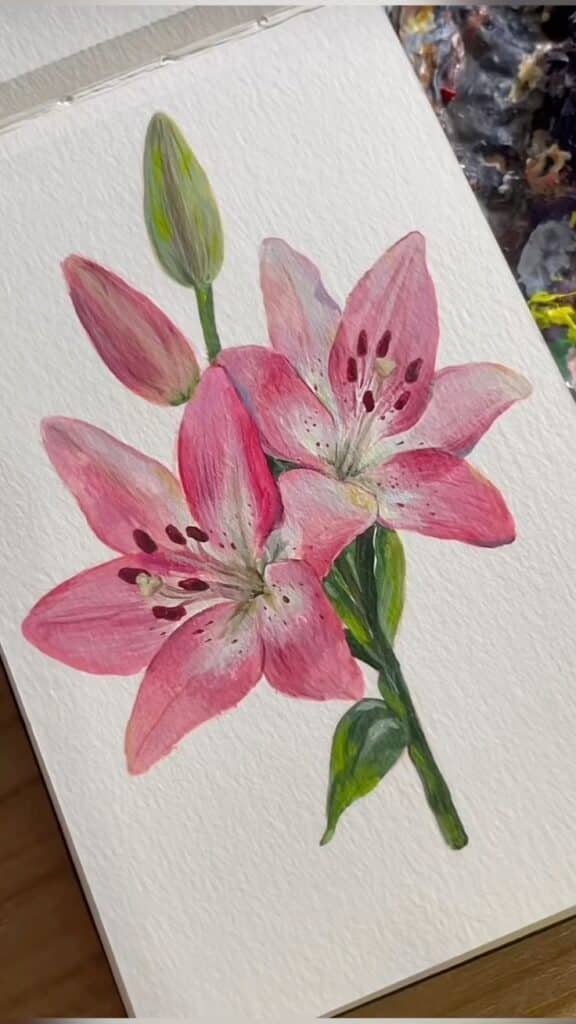
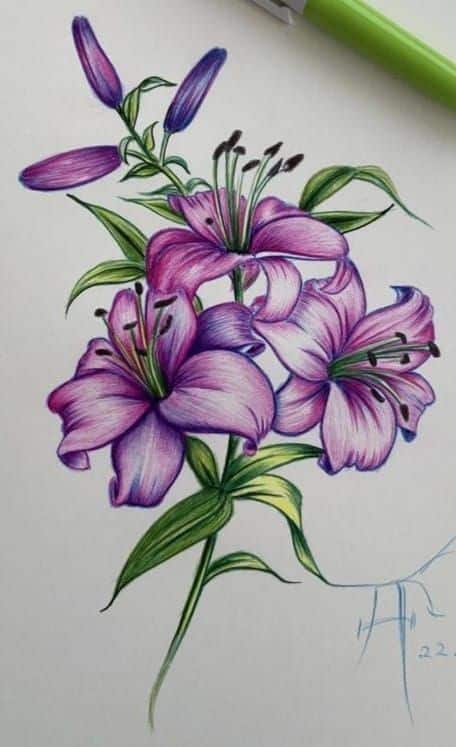

Essential Techniques for Lily Flower Drawing
Mastering lily flower drawing requires understanding a few key techniques that bring these elegant blooms to life on paper. The right approach to sketching, petal formation, and shading can transform a simple outline into a beautiful artistic creation.
How to Draw a Lily Step by Step
Start with a light circle as your guideline for the flower’s center. This doesn’t need to be perfect—nature rarely is! Next, sketch the trumpet-like shape extending from this circle, which will form the main part of the lily.
Add 5-6 petals around this central trumpet. Lilies typically have six petals that curl outward and sometimes backward. Draw them with gentle curves rather than straight lines.
For the stamen, add a thin central pistil with several anthers extending from it. These should be slightly longer than the trumpet part of the flower.
Finish with a simple stem using two parallel lines. Remember to keep your initial lines light so you can adjust and refine as you go along.
Sketching Lily Petals and Leaves
Lily petals have a distinctive elongated shape with pointed tips. When drawing petals, vary their positions—some facing forward, others curling back—to create a natural look. Each petal should have a slightly different shape and angle.
Pay attention to how petals overlap. This creates depth in your drawing. The visible edges of overlapped petals should be drawn with slightly darker lines.
Lily leaves are long and slender with parallel veins running their length. They grow in an alternate pattern along the stem. When sketching leaves, start with the central vein, then outline the leaf shape around it.
Use light, curved strokes to capture the natural bend of leaves. This adds movement to your drawing and prevents it from looking stiff.
Adding Realistic Texture and Shading
Shading brings your lily drawing to life. Start by identifying your light source, then add shadows on the opposite side of petals and leaves. The inner trumpet area typically appears darker.
Use gentle pencil strokes that follow the natural curve of the petals. This technique, called contour shading, enhances the three-dimensional quality of your drawing.
For texture, add fine lines along the length of petals to represent natural ridges. The central parts of lilies have a more textured appearance, so use small dots or short strokes here.
Don’t forget to shade the stem and leaves with lighter pressure. Leaves often have a slightly different texture than petals, so vary your pencil technique accordingly.
Highlights are just as important as shadows. Leave small areas unshaded where light would hit the flower directly to create a realistic sheen on your lily drawing.
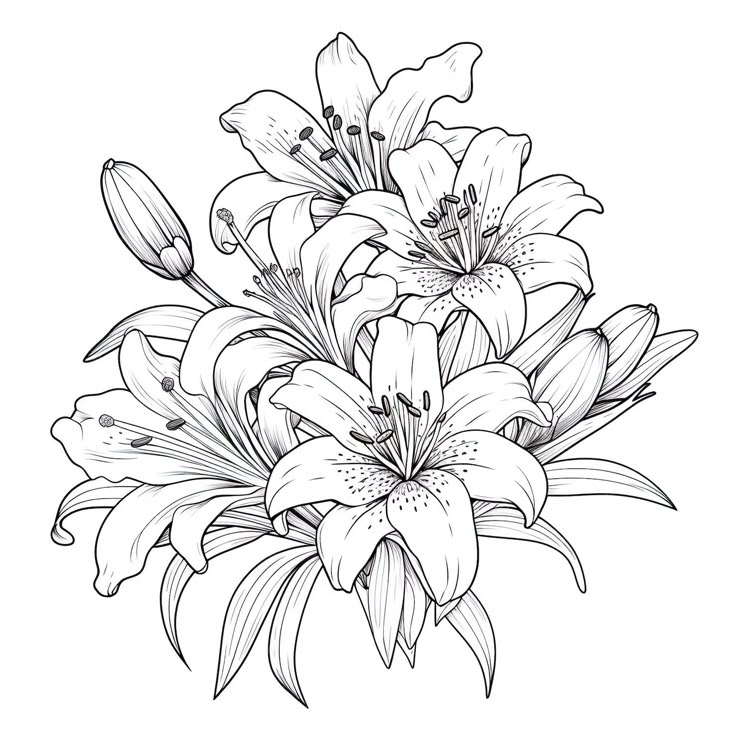
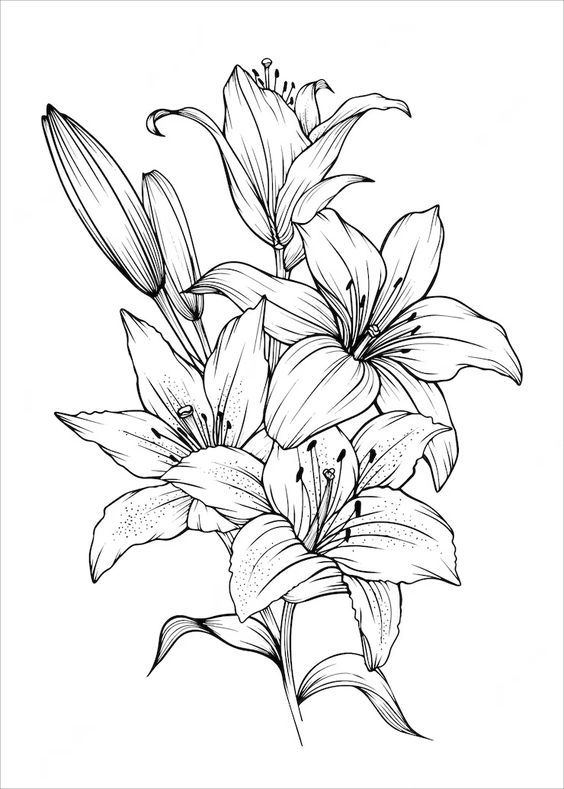
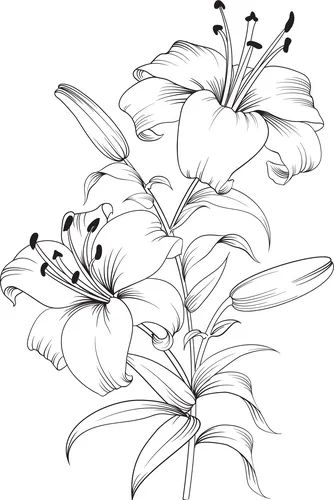
Digital and Artistic Mediums for Lily Drawing
Exploring different mediums for lily drawing can significantly enhance your artistic expression. Today’s artists have access to both traditional and cutting-edge digital tools that offer unique advantages for capturing the elegant beauty of lilies.
Traditional Tools Versus Digital Art
Traditional tools like graphite pencils, charcoal, and watercolors have been used for centuries to create stunning lily illustrations. These mediums offer a tactile experience that many artists find irreplaceable.
Digital platforms like Procreate have revolutionized flower illustration. As suggested in search results, Procreate tutorials specifically for realistic lily drawings are becoming increasingly popular in 2025.
Vector-based programs allow you to create clean line art of lilies that can be scaled to any size without losing quality. This is particularly useful for creating minimalist lily outlines or continuous line drawings.
The beauty of digital art lies in its flexibility. You can experiment with different brushes, textures, and colors without wasting materials. Plus, the undo button is your best friend when working on intricate lily petals!
Working with AI Generated Content
AI tools have transformed how artists approach lily drawings. These platforms can generate reference images or even complete lily illustrations based on simple text prompts.
You can use AI-generated content as starting points for your own unique creations. Try requesting “simple line art drawing of a lily” to get inspiration for your minimalist flower illustrations.
The key is finding balance—AI can help with initial concepts, but your artistic touch makes the work truly special. Consider using AI to generate various lily perspectives that might be challenging to visualize otherwise.
Remember that AI-generated lily illustrations can be refined in traditional drawing programs. You might take a generated outline and add your own shading techniques or color palettes to create a truly personal piece.
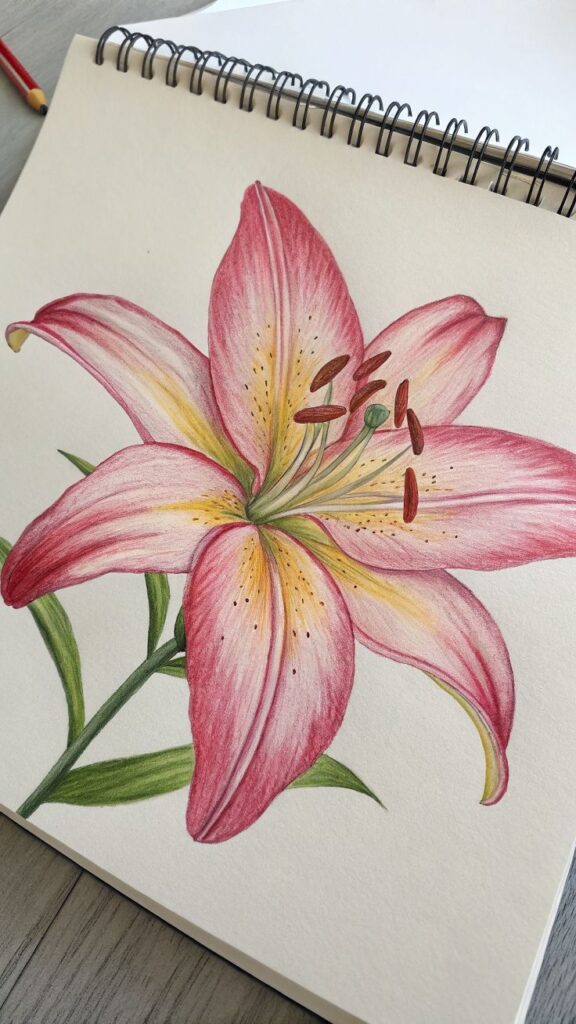
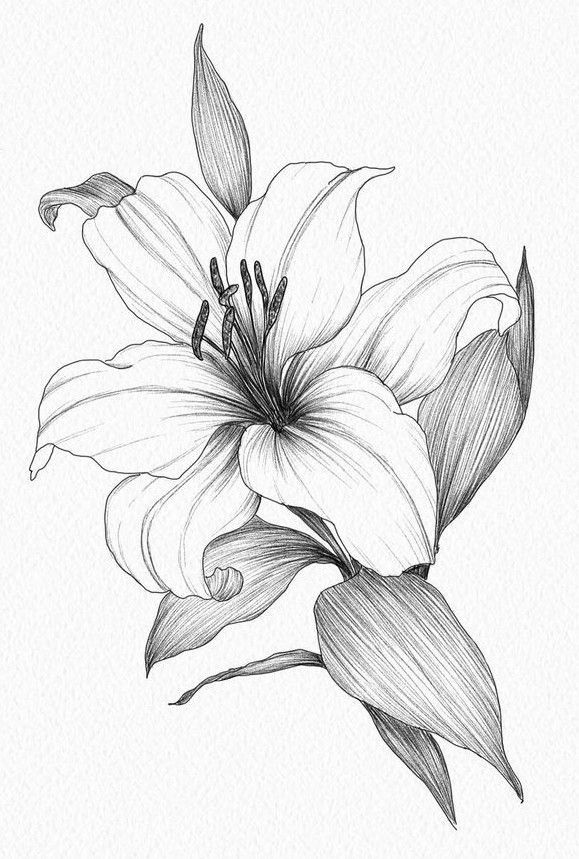
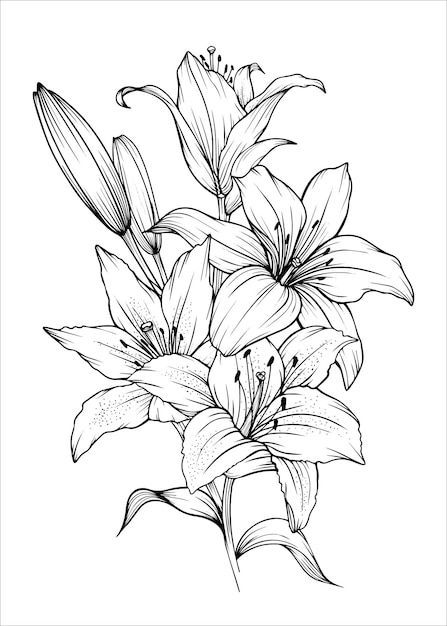
Optimizing and Sharing Your Lily Flower Drawings
Once you’ve completed your lily flower drawing, there are several ways to enhance its presentation and share it effectively with others. The right format and presentation can make your artwork stand out and appear more professional.
Image Orientation and Resolution Tips
When finalizing your lily drawing for sharing or display, resolution matters tremendously. Aim for at least 300 DPI (dots per inch) if you plan to print your artwork, as this ensures crisp, clear details of your lily’s delicate petals and stamens.
For digital sharing on social media, 72-150 DPI is usually sufficient. Many artists take a high-resolution photo or scan of their lily drawing in good natural lighting to capture the true colors and details.
Avoid compressed file formats like low-quality JPEGs that can lose detail. Instead, consider PNG for digital sharing or TIFF for printing to preserve the subtle shading in your lily drawing.
Choosing Color Composition
The color palette you select can dramatically impact how your lily drawing is perceived. White lilies benefit from subtle shadows in cool blues or purples, while orange or pink lilies pop against complementary green backgrounds.
Consider using limited color palettes of 3-5 colors for a harmonious look. This approach creates cohesion while still allowing you to highlight the lily’s natural beauty.
Try experimenting with monochromatic schemes using different shades of a single color. This can create a sophisticated, elegant feel perfect for lilies.
Don’t be afraid to explore unconventional color combinations! A purple lily against a warm yellow background creates striking visual interest through complementary colors.
Portrait, Landscape, Square, and Panorama Formats
Portrait orientation (taller than wide) works beautifully for single lily stems, emphasizing the flower’s graceful vertical growth. This format showcases the elegant curve of the stem and the lily’s distinctive trumpet shape.
Landscape orientation (wider than tall) is ideal for capturing multiple lilies or showing a lily in its natural setting. This format allows you to illustrate how the flowers relate to their environment.
Square formats create balanced compositions perfect for social media platforms like Instagram. They work particularly well for close-ups of a single lily bloom where you want to highlight intricate petal details.
Panoramic formats can beautifully capture a field of lilies or an unusual perspective, like looking up at a lily from below. This dramatic format creates immersive, eye-catching artwork that stands out in galleries or online portfolios.
Lily Flower Drawing in Stock and Editorial Media
Stock image websites offer vast collections of lily flower drawings, making it easy for creatives to find the perfect illustration for their projects. These platforms provide various licensing options to suit different needs and usage requirements.
Finding and Using Royalty-Free Lily Illustrations
Platforms like Shutterstock host thousands of lily flower drawings in various styles and formats. You can find everything from detailed botanical illustrations to minimalist line drawings of lilies. These images are available in high-definition quality, ensuring they look professional in your projects.
When searching, try specific terms like “lily line drawing” or “lily flower illustration” to narrow down results. Most stock sites allow filtering by orientation, color, or style to help you find exactly what you need.
Royalty-free licensing means you pay once and can use the image multiple times without additional fees. This makes it cost-effective for blogs, presentations, or marketing materials.
Editorial and Extended Licenses
Some lily drawings come with editorial licenses, which limit usage to non-commercial, informational contexts like news articles or educational materials. Always check the license type before downloading.
For commercial projects, you’ll likely need standard or extended licenses. Extended licenses provide broader usage rights, allowing you to incorporate lily illustrations into products for sale, such as greeting cards or printed merchandise.
Sites like Dreamstime offer various licensing tiers with clear explanations of permitted uses. If you’re unsure about license requirements, most platforms provide helpful guides or customer support.
Safe Search and Image Suitability
Stock image platforms typically include safe search features to ensure appropriate content. This is particularly helpful when searching for natural subjects like lily flowers in educational or family-friendly contexts.
You can often filter images by complexity, making it easier to find simpler lily drawings for children’s materials or more detailed botanical illustrations for scientific publications.
Consider the intended audience when selecting lily illustrations. Formal botanical drawings work well for scientific or educational purposes, while stylized or decorative lily drawings might better suit artistic or commercial projects.
Many platforms also indicate image popularity or trending status, helping you gauge which lily drawings resonate with current design trends.
Exploring Inspirational Resources for Lily Drawings
Finding quality reference materials is crucial for creating realistic and beautiful lily drawings. The right resources can help you understand the flower’s unique structure and capture its elegant curves and delicate petals accurately.
Videos and Step-by-Step Guides
YouTube offers excellent lily drawing tutorials for artists at all skill levels. These videos break down the drawing process into manageable steps, making it easier for you to follow along. Many tutorials, like “Lily Drawing Tutorial for Beginners,” demonstrate the entire process from basic sketching to adding intricate details.
Pinterest is another goldmine for lily drawing inspiration. According to search results, thousands of people search for “Drawing lily flower” and “Lily flowers drawings” on the platform. You’ll find collections of everything from minimalist line art to vibrant, detailed illustrations.
Step-by-step guides often show you how to draw different lily varieties, including Easter lilies, calla lilies, and tiger lilies. These guides typically cover essential techniques like creating petal shapes, adding texture, and incorporating stems and leaves.
360° Panoramic Images for Reference
Using 360° panoramic images as reference material gives you a comprehensive view of lilies from every angle. These interactive references allow you to rotate around the flower, studying how light interacts with petals and how the structure changes from different perspectives.
Several botanical gardens and flower databases now offer 360° views of various lily species in their natural settings. This type of reference is particularly valuable when drawing lily arrangements or when you need to understand the three-dimensional form of the flower.
You can find these panoramic references through specialized photography websites, virtual garden tours, and some plant identification apps. The ability to zoom in on specific parts of the lily helps you capture fine details like the stamen, pistil, and the delicate texture of petals.
- 12.1Kshares
- Facebook0
- Pinterest12.1K
- Twitter0


